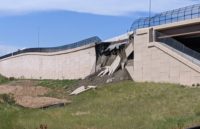There is some urgency, however, to finish the bulk of the work as soon as possible, says Mindy Crane, deputy director of communications for CDOT. "The next 60 days are critical," she says, "because we don't have a lot of time before winter hits, especially in those canyons and the foothills."
Water Infrastructure
Several communities are still under no-flush and boil-water advisories because of broken water pipelines or treatment plants taken off line during the floods. "Crews are working day and night to repair blocked or damaged sanitary sewer lines compromised during the flood and filled with debris," the city of Boulder said on its website. Residents in Evans, south of Greeley, experienced eight days of a no-flush rule until Sept. 21.
"Electric, water, natural gas and sanitary sewer were affected by the floods in Estes Park," says Steve Ravel, a project manager with the Lakewood, Colo., office of wet infrastructure engineers Hatch Mott MacDonald. Ravel has been inspecting water systems in the area since the flood. "The Upper Thompson Sanitation District's lines are over 30 years old and have sustained damage, including destroyed manholes and pipes as well as lines filled with rocks and debris."
Dam safety officials and engineers are inspecting nearly 200 area dams, including high-, medium- and low-hazard structures, to determine damage and further risk of failure. Most of the dams in question are located along the St. Vrain and South Platte rivers, where at least nine low-risk structures failed. Many others are still inaccessible, except by helicopter.
Most of the damage recorded so far has been to outlets, spillways and downstream collection ponds overwhelmed by rising water. More than 70 reservoirs released overflow from their spillways during the storm, according to Colorado Division of Water Resources' dam-safety branch.
The agency has moved all its dam inspectors from Colorado's Western Slope to help with the work. Nearly 60 engineering firms have contacted dam-safety officials to assist with inspections, which began on Sept. 20. The inspection teams will attempt to do six months of work within 10 days, the agency says. It is the largest dam inspection effort in the state's history.
Early inspections are "mostly triaging" the dams, says John W. France, vice president and national dam technology leader at URS Corp., Denver. URS has been assigned to inspect 14 dams, mostly in the Boulder area. "We've been asked to determine which ones have compelling reasons to alert emergency-management officials about possible downstream dangers," he says. "The teams are looking for things like seepage that wasn't there before or extreme spillway erosion," he adds.






Post a comment to this article
Report Abusive Comment